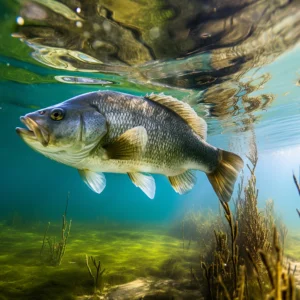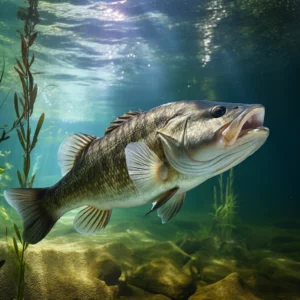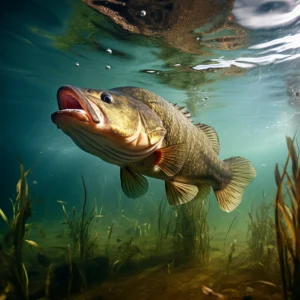So, you’re out on the water trying to reel in some bass, huh? Well, if you want to up your game and catch more fish, you might need to venture into deeper waters. That’s right, today we’re going to talk about deepwater bass fishing techniques. Now, you might be wondering just how deep you should be fishing for those elusive bass.
Well, my friend, the answer is not as simple as a specific number. It actually depends on a few factors like water temperature, time of day, and the season. Typically, bass tend to reside in shallower waters during spawning season, but as the water warms up and summer hits, they often seek refuge in deeper areas to escape the heat.
In fact, during the hot summer months, you might find bass lurking in depths of 10 to 20 feet or even more. They tend to hang around structures like submerged trees, rocks, or drop-offs, so keep an eye out for those spots when you’re out on the water. We’ll dive deeper into specific techniques and gear in the article, so stay tuned for more tips on how to successfully fish in deepwater for bass.
Deepwater Bass Fishing Techniques
Welcome to the exciting world of deepwater bass fishing! If you’ve been honing your skills in shallower waters and are now ready to explore the depths, you’re in for an adventure. In this article, we will guide you through the techniques and strategies that will help you become a successful deepwater bass angler.
Exploring the Depths for Bass
As you venture into deepwater bass fishing, it’s crucial to understand the significance of depth. Bass tend to move to deeper waters as the seasons change, seeking cooler temperatures and more abundant prey. Depending on the time of year and your location, the ideal depth for bass fishing can vary. Let’s dive deeper into finding the perfect depth for bass fishing.
Finding the Ideal Depth for Bass Fishing
To determine the ideal depth for bass fishing, start by researching the water body you plan to fish in. Look for any underwater structures such as drop-offs, ledges, or submerged islands, as these are prime areas where bass are likely to be hiding. Use a fish finder to help identify these structures and determine their depth.
Another effective approach is to pay attention to the behavior of the bass. Look for signs of activity such as jumping fish, feeding birds, or ripples on the surface. Bass are known to follow their prey, so these signs can give you clues about where they might be congregating in deeper waters.
Understanding Bass Behavior in Deep Water
When fishing in deepwater, it’s crucial to have a good understanding of bass behavior. Unlike in shallower waters, bass in deeper depths are generally less active and more sedentary. They conserve energy by staying close to structures and waiting for prey to come to them.
Take advantage of this behavior by targeting key areas such as drop-offs, submerged brush piles, or rock formations. These structures provide cover where bass can hide and ambush their prey. By casting your line near these structures and using the right techniques, you increase your chances of enticing a bass to bite.
| Month | Ideal Depth (ft) | Preferred Lure | Successful Technique |
|---|---|---|---|
| January | 20-30 | Jig | Jigging |
| February | 20-30 | Deep Diving Crankbait | Slow Retrieve |
| March | 15-25 | Swimbaits | Steady Retrieve |
| April | 10-20 | Jig | Jigging |
| May | 5-15 | Soft Plastic Bait | Drop Shot |
| June | 10-20 | Crankbait | Varying Speed Retrieve |
| July | 20-30 | Swimbaits | Slow Retrieve |
| August | 25-35 | Deep Diving Crankbait | Pausing Retrieve |
| September | 15-25 | Jig | Jigging |
| October | 10-20 | Soft Plastic Bait | Drop Shot |
| November | 15-25 | Swimbaits | Slow Retrieve |
| December | 20-30 | Jig | Vertical Jigging |
Choosing the Right Lures for Deepwater Bass Fishing
Selecting the right lures for deepwater bass fishing is essential to attract the attention of these elusive fish. Deep-diving crankbaits, jigs, and swimbaits are some of the most effective lures for targeting bass in deeper depths.
Crankbaits are designed to dive deep, mimicking injured baitfish. They create a realistic swimming action that can trigger a bass to strike. Opt for natural colors that match the prey fish in the water body you’re fishing in.
Jigs are another go-to lure for deepwater bass fishing. Their versatility allows you to target different depths and cover various structures effectively. Try different colors and sizes to see what the bass in your area prefer.
Swimbaits have gained popularity among deepwater bass anglers due to their lifelike appearance and enticing swimming action. These soft plastic lures imitate baitfish, providing an irresistible meal for big bass lurking in the depths.
Drop Shot Technique: A Key to Success in Deepwater Bass Fishing
One technique that stands out in deepwater bass fishing is the drop shot technique. This finesse technique involves rigging a soft plastic bait above a weight, allowing it to suspend above the bottom. The drop shot technique is effective in deepwater because it keeps your lure at the ideal depth, right in the face of those passive bass.
To set up a drop shot rig, tie a hook to your line, leaving a tag end of approximately one to two feet. Attach a drop shot weight at the end of the line. Experiment with different bait options such as worm imitations or minnow-shaped lures until you find what works best for your fishing conditions.
Crankbait Techniques for Deepwater Bass Fishing
When it comes to using crankbaits for deepwater bass fishing, mastering the right retrieval technique is crucial. Since these lures dive deep, you need to bring them back to the surface in a way that mimics the action of injured prey.
Start by casting your crankbait near underwater structures or drop-offs. Once your lure reaches the desired depth, retrieve it using a steady, medium-paced retrieve. Vary your retrieve speed and incorporate occasional pauses or jerks to imitate an injured fish. This erratic movement often triggers a reaction strike from the bass.
Jigging Techniques for Deepwater Bass Fishing
Jigging is another effective technique for catching bass in deepwater. This involves bouncing or dragging a jig along the bottom to imitate a crawfish or other bottom-dwelling prey. By mimicking the movements of their preferred meals, you increase the chances of enticing a bass to bite.
Cast your jig near structures or drop-offs and let it sink to the bottom. Once it touches the bottom, start working the jig by lifting it slowly and then allowing it to fall back down. Often, the bites come when the jig is falling, so remain attentive and be ready to set the hook when you feel a subtle tap or pressure on the line.
Swimbaits: A Game Changer in Deepwater Bass Fishing
Swimbaits have revolutionized the world of bass fishing, particularly for targeting larger bass in deeper waters. These realistic lures replicate the movement and appearance of real fish, fooling even the most cunning bass.
To fish with swimbaits, cast your lure out into the deeper waters near structures or drop-offs. Retrieve the swimbait with a slow, steady retrieve, imitating the swimming motion of a wounded fish. Pay attention to any strikes or tugs on the line, as bass can aggressively strike a swimbait.
Vertical Fishing Techniques for Deepwater Bass
Vertical fishing is an effective method for targeting bass in deep water. This technique involves dropping your lure directly below your boat or kayak and working it up and down in the water column until you find the depth where bass are holding.
Vertical jigs, spoons, and blade baits work exceptionally well for this technique. Experiment with different techniques, such as fluttering the lure as it falls or aggressively jigging it off the bottom. Keep an eye on your fish finder to determine the depths at which bass are suspended and adjust your lure accordingly.
Conclusion
Congratulations! You have now learned some essential deepwater bass fishing techniques that will help you navigate the depths with confidence. Remember to research your fishing location, understand bass behavior, and select the right lures for the job. Whether you opt for the drop shot technique, crankbaits, jigs, swimbaits, or vertical fishing, adapt your approach to the conditions at hand and be prepared to experiment until you find what works best for you.
So, gear up, head out to the deep waters, and let the adventure begin. Happy fishing!




